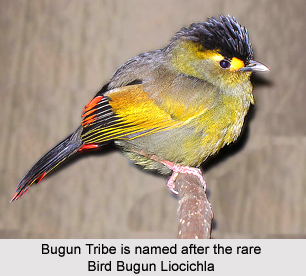 Bugun Tribe also known as the Khowa is a tribal group in India. They live mainly in the subtropical Tenga Velley or Singchung Administrative Circle of West Kameng district. The whole native population of Bugun Tribe is under 6-Thrizino-Buragaon Assembly Constituency of the state of Arunachal Pradesh. According to the ancient mythological legend, it is believed that they are the descendants of the Achinphumphulua.
Bugun Tribe also known as the Khowa is a tribal group in India. They live mainly in the subtropical Tenga Velley or Singchung Administrative Circle of West Kameng district. The whole native population of Bugun Tribe is under 6-Thrizino-Buragaon Assembly Constituency of the state of Arunachal Pradesh. According to the ancient mythological legend, it is believed that they are the descendants of the Achinphumphulua.
Bugun Tribe is further subdivided into different sections according to their specific locality. These are Hakhongdua, Hajidua, Braidua, Khuchundua, Hayindua. The populations are mainly concentrated in the villages namely - Wanghoo Village, Dikhiyang Village, Bichom Village, Ramu Village, Lali Village, Situ Village, Sachida Village, Lichini Village, Ditching Village, Mangopam Village, Singchung Village, Namfri Village and Kaspi Village. Their immediate neighbours are Aka Tribe (Hrusso), Miji Tribe(Sajalong/Dhammai), Sherdukpen Tribe and Monpa Tribe.
The shifting cultivation or the Jhum is practiced. The domestic animals such as cow, horse, pig, sheep, goat, fowl and the mithun are reared. To enrich their diet, wild animals are hunted using simple spears, traps, bows and arrows by the local tribal people.
Together with the Miji Tribe and Aka Tribe, the people of Bugun Tribe keep long hair. The long hairs are kept by some members of both sexes. While the both sexes adorn themselves with silver ornaments, the men wear a very long white garment and a very high hat, resembling a Turkish Fez. The women wear a skull cap, sometimes decorated with beautiful patterns. Purple and checkered jackets are worn as well, usually accompanied by another singlet. The language of Bugun Tribe is grouped with the neighboring languahe Mey language as Bugun-Mey language. It is possibly of Tibeto-Burman derivation in the state.
The Khowa or Bugun Tribe are followers of the Donyi-Polo religion and have come under Tibetan Buddhist influence from the neighbouring ethnic group Sherdukpen Tribe. There lies the profound Buddhist influence that has led to the adoption of many Buddhist rituals and the invitation of Buddhist lamas to participate in their communal rituals. As a result, many Khowa or the Bugun Tribal people declared themselves as Buddhist as religion. However, animism is still profound with majority of them.
Especially in Sraiba, a place or a ground for worship and related festive celebration of every major village like Kshyatsowai/Dihing Kho and Pham Kho Festival is celebrated by the Bugun. The Phabi priest plays an important role in conducting the ceremony and religious rituals. The songs and dances such as Clown and Gasisiu have a close affiliation with their religion. Feasts during these festivals mainly include their traditional foods and Phua.
The traditional village committee of the Bugun Tribe or the Khowa community is known as Nimiyang (Council of Elders). The Council of Elders looks after every aspect of village life, may it be decision-making, utilization of local resources, conflict resolution or regulating the society. Each family is represented in the Nimiang sessions by its head male member. The traditional village council of Buguns is headed by Thap-Bahow (Chief). The Thap-Bakhow is an accepted leader and selected unanimously and not hereditary. There is no strict criterion for selection of the Thap-Bakhow, but a person with economic affluence, social stature, and knowledge of customary laws, sound mentality, physical strength and generosity are taken into consideration. He presides over the meetings and sittings of the Nimiyang session. It is customary that only male member possessing above qualities can become Thap-Bakhow. Womenfolk are just a passive spectator and witnesses the proceedings of the Nimiyang sessions only. However, a female member is allowed to represent if its male member is absent. In the year 2006, a rare bird Bugun Liocichla was named after the tribe called Bugun Tribe.
















